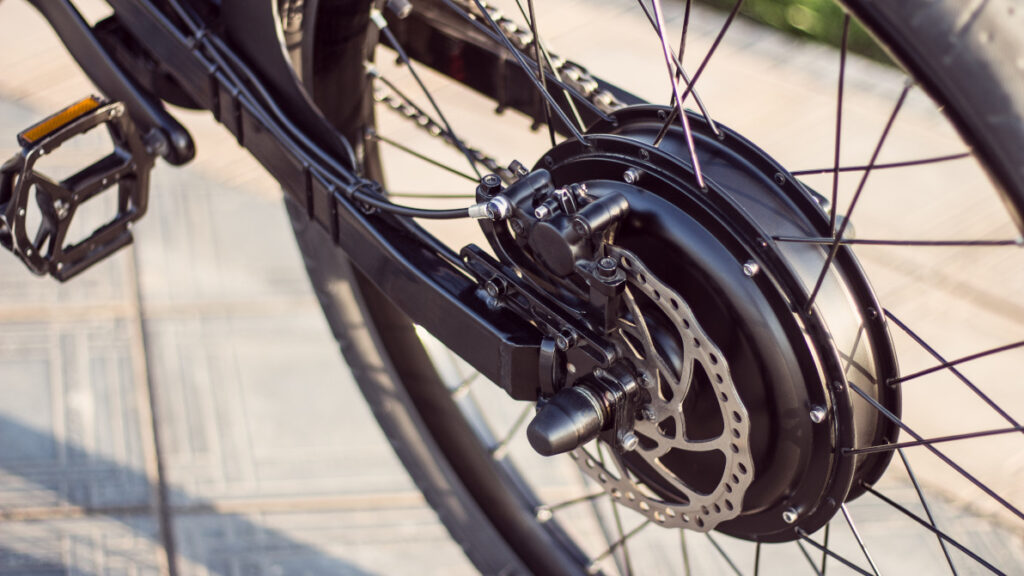Ultimate Guide to Choosing the Best Electric Bike: A Comprehensive EBike Buyers Guide
If you’re considering buying an electric bike you need an ebike buyers guide so that you know what to look for in an electric bike.
The world of electric bikes (e-bikes) has seen a remarkable surge in popularity, and for good reason. These eco-friendly and efficient alternatives to traditional bicycles offer a thrilling ride while minimizing your commuter carbon footprint.
However, with the various of options available in the market, finding the perfect e-bike can be a daunting task. Fear not! In this comprehensive e-bike buyer’s guide, we’ll explore key features that can make or break your e-bike experience: motor location, motor power, and battery power.
Motor and Battery
Motor Location
One of the first decisions you’ll encounter when shopping for an e-bike is where the motor is located. There are three primary motor positions: front hub, rear hub, and mid-drive. Each has its advantages and considerations.
Front Hub Motors:
Front hub motors are positioned in the front wheel of the e-bike. They are known for their simplicity and are often found in entry-level models. The advantages include easier installation and maintenance, as well as a balanced weight distribution. However, front hub motors may not provide optimal traction, especially on uneven terrain, and can affect steering in certain situations.
Rear Hub Motors:

Rear hub motors are located in the rear wheel, providing a more natural riding experience. They are a good choice for an electric mountain bike, offering better traction than front hub motors and are often preferred for their ability to climb hills with ease. Rear hub motors also tend to be quieter than their front counterparts. On the downside, maintenance can be more complicated, and the overall weight distribution may feel less balanced.
Mid-Drive Motors:
Mid-drive motors are positioned at the bike’s center, typically near the pedals. This location offers several advantages, including a lower center of gravity, improved balance, and efficient power utilization. Mid-drive motors are ideal for tackling steep hills and challenging terrains.
However, they tend to be pricier and may require more maintenance compared to hub motors. Keep in mind a mid-drive motor requires the chain to move the rear wheel if for some reason the chain should break or pop off you can no longer use the motor or pedal manually to ride your bike
Choosing the motor location depends on your riding preferences and the terrain you’ll be navigating. If you prioritize simplicity and even terrain, a front or rear hub motor may be sufficient. For those seeking versatility and power on varied landscapes, a mid-drive motor might be the better choice.
Keep in mind a mid-drive motor requires the chain to move the rear wheel if for some reason the chain should break or pop off; you can no longer use the motor or pedal manually to ride your bike. A front or rear hub motor can drive your bike even if the chain breaks or pops off because it directly drives the wheel without the need for a chain.
Motor Power
The power of an e-bike motor significantly influences its performance. Motor power is measured in watts (W) and determines the level of assistance the bike provides. Generally, e-bikes have motors ranging from 250W to 750W, with some high-performance models exceeding this limit. Here’s a breakdown of the motor power and what it means for your riding experience.
250W-500W Motors:
E-bikes with motors in this range are suitable for city commuting and leisurely rides. They provide a gentle boost, making them great for riders who want assistance without sacrificing the feel of traditional biking. Keep in mind that lower-powered motors may struggle on steeper inclines and rough terrains.
500W-750W Motors:
Mid-range motors offer more power, making them versatile enough for urban commuting and light off-road adventures. With increased wattage, these e-bikes can handle hills more effectively and provide a more substantial push, especially during acceleration.
750W Electric Bike and Above:
If you live in an area with big hills or are a full grown adult you definitely want a 750 watt motor or above. High-powered motors are designed for off-road enthusiasts and those who crave a thrilling, fast-paced ride.
These e-bikes can conquer challenging terrains, steep hills, and offer an exhilarating experience. However, be aware that some regions have legal restrictions on the maximum power allowed for e-bikes, so it’s crucial to check local regulations.
Selecting the right motor power depends on your intended use. If you plan to stick to city streets and gentle trails, a lower wattage may suffice. For those seeking a more adventurous journey with off-road exploration, a higher-powered motor is the key to an enhanced riding experience.
Battery Power For an Ebike
The battery is the lifeblood of an e-bike, determining how far and how long you can ride between charges. When evaluating battery power, consider its capacity (measured in watt-hours, Wh) and voltage (V). Here’s what you need to know to make an informed decision.
To find your ebike watt hours you simply multiply ( VOLTS X Amp Hours). Using this formula will help you determine a few thing.
- If the battery is powerful enough to actually drive the motor and take advantage of the full power of the electric motor.
- Approximately how long your battery will last on throttle mode only.
For example: If the ebike has a 750 watt motor with a 48 volt battery with 10 amp hours is not going to be enough power to get the full potential out of the motor.
Here’s why, using the formula (48 volt X 10 amp hours = 480 watts hours). It will drive the motor but won’t allow the motor to unleash its full potential and only run the motor on electric throttle only for about 25 to 30 minutes, not taking into consideration rider weight and terrain.
That being said if you have a:
750 watt motor you want to have at minimum a 48 volt 17.5 amp hour battery.
Using the above mentioned formula you can see why. (48 volts X 17.5 amp hours = 840 watt hours.)
This shows us that the battery can fully power the 750 watt motor and in theory last about an hour on throttle only mode. Again not considering rider weight and terrain demand.
As you shop for an ebike it is extremely important to take this into consideration so that you are not disappointed with your ebikes performance.
Battery Capacity (Wh):
Battery capacity is a crucial factor in determining the range of your e-bike. Higher capacity batteries store more energy, allowing for longer rides between charges. Typical e-bike batteries range from 300Wh to 700Wh, with some high-end models exceeding 1,000Wh. Keep in mind that factors such as rider weight, terrain, and assist level can impact the actual range.
Battery Voltage (V):
Battery voltage influences the power delivery to the motor. Most e-bikes use 36V or 48V systems. Higher voltage batteries often provide more torque and better performance, especially on hilly terrain. However, they can be bulkier and heavier.
Integrated vs. Removable Batteries:

Some e-bikes come with integrated batteries that are seamlessly incorporated into the frame, providing a sleek and cohesive look. On the other hand, removable batteries offer the convenience of easy charging and can be replaced if needed. A good feature to look for on a removable battery is if it has a lock built into the bike to help prevent theft. Consider your preference for aesthetics and practicality when choosing between integrated and removable options.
Charging Time:
Charging time is another essential consideration. Most e-bike batteries take a few hours to charge fully, but the charging time can vary. Some e-bikes come with fast-charging capabilities, allowing you to top up the battery quickly when needed.
In conclusion, selecting the right battery is crucial for a satisfying e-bike experience. If you plan to take longer rides or tackle challenging terrains, opting for a higher capacity battery with a higher voltage may be worth the investment. Conversely, if your rides are short and primarily on flat terrain, a lower capacity battery might suffice.
Additional Considerations To Find The Best Electric Bike
Frame Design and Size:
E-bike frames come in various designs, including step-through, mountain bike, and hybrid styles. Choose a frame that suits your riding preferences and provides a comfortable fit. Size matters too; ensure the e-bike is available in the right frame size for your height.
A Folding Bike:
Folding e-bikes are super handy! They fold up small for easy storage and can fit in most car trunks, perfect for city life and transporting you bike to a lacation that you want to ride. You can bring them on the bus or store them in a closet. Plus, they have a boost from the electric motor, making rides to school or around town a breeze!
Brakes and Gearing:
High-quality brakes are essential for safety, especially given the added speed and weight of e-bikes. Disc brakes, both hydraulic and mechanical, are common choices for their reliable stopping power. Additionally, consider the gearing system, as it influences the bike’s efficiency and performance on different terrains.
Tires and Suspension:
The type of tires and suspension on your e-bike can significantly impact your riding experience. Thicker tires provide more stability and traction, while suspension systems absorb shocks for a smoother ride. Consider your intended use and terrain when choosing the appropriate tires and suspension.
Display and Controls:
The display and control interface on your e-bike play a crucial role in accessing information and adjusting settings. Look for an intuitive and easy-to-read display, along with ergonomic controls that allow you to seamlessly adjust assist levels and monitor battery life.
E-Bike Classification:
- Class 1 E-Bike: Relies solely on pedal assistance, capping its speed at 20 mph. Classified as a bicycle, a Class 1 bike enjoys the same flexibility as a traditional bicycle—wherever a bicycle is permitted, so is a Class 1 electric bike.
- Class 2 E-Bikes: Combine both pedal assistance and a throttle, sharing the 20 mph speed limit with Class 1 counterparts. They mirror the riding privileges of Class 1 bikes in most areas. However, certain counties or states restrict Class 2 electric bikes from naturally paved, dirt, or single-track trails, differing from Class 1 permissions.
- Enter Class 3: E-Bikes, pedal-assist wonders with a higher speed threshold of 28 mph. While suitable for roads and bike lanes, the narrative changes in most regions—Class 3 bicycles typically find restrictions on unpaved surfaces, multi-use trails, and protected bike lanes, setting them apart from their Class 1 and 2 counterparts.
Conclusion
Navigating the world of e-bikes can be an exciting but overwhelming experience. Whether you want a cargo bike mountain bike or road bike. By understanding key features such as motor location, motor power, and battery power, you can make an informed decision that aligns with the bikes cost and your riding preferences and lifestyle. Whether you’re commuting to work, exploring off-road trails, or riding in the city.
By using this ebike buyer guide it will help you make an informed purchase and you will know what to look for in an electric bike. Check out our Electric Bike Troubleshooting Guide and you can avoid ever taking your electric bike to the bike shop.

